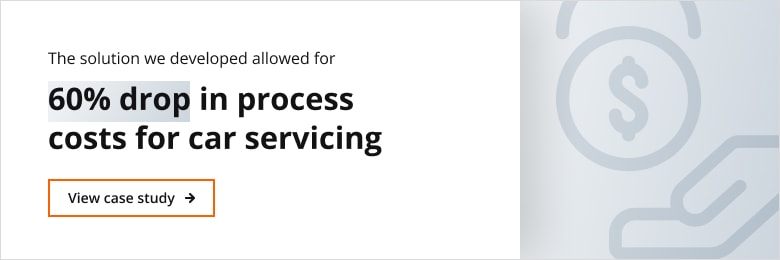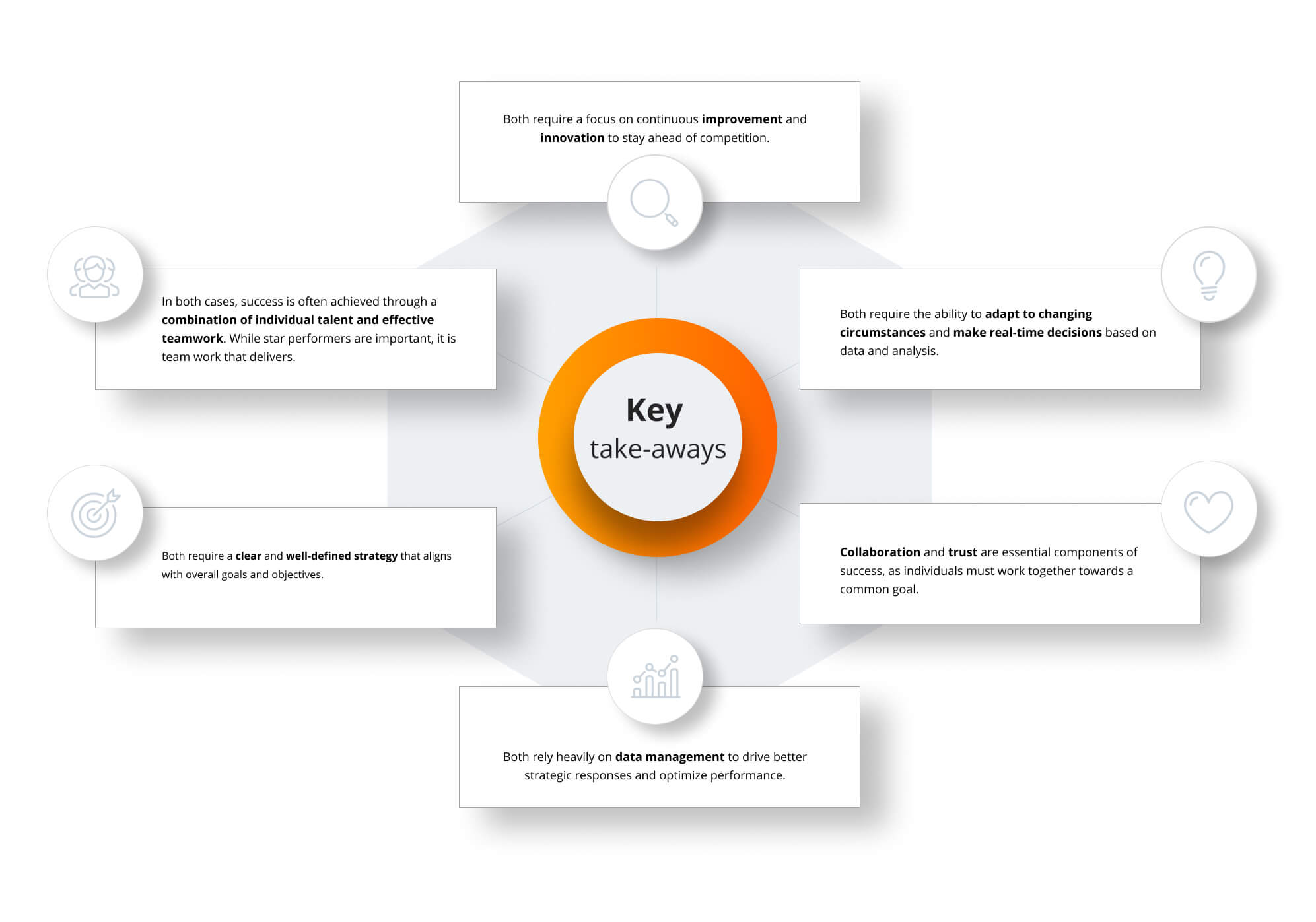
Key common elements between business and Formula 1 strategy – what can we learn from F1 races?
In many ways, business and Formula 1 racing may seem entirely different worlds. One is a high-stakes, high-speed competition on the racetrack, while the other is a complex web of operations - from marketing to finance, production, and management. However, when you dig deeper, you'll find that there are actually many key common elements between business and Formula 1 strategy.
Key similarities in strategy and beyond
One of the most obvious parallels is the importance of resource management. In business, this might mean carefully managing resources, investing in key assets, and smart allocating them to different projects and initiatives. In Formula 1, it means managing everything from tires, logistics, innovation, and fuel to the team’s budget and personnel.
As we saw in 2022, the Ferrari team nearly lost second place in the constructors’ championship to Mercedes in part due to a miscalculation of tire wear during a critical race.
Similarly, businesses can face significant setbacks if they mismanage their resources or fail to account for unexpected challenges.
Another key similarity is the importance of personnel decisions and talent management. Just as businesses need to carefully select, train, and develop the right talent to execute their strategy, Formula 1 teams must choose the right drivers, engineers, and other team members to maximize their chances of success.
For example, Fernando Alonso, one of the most successful drivers in the sport’s history, most races completed in the sport, and double World Champion and now driving for Aston Martin in 2023, has said:
If you’re in the best team in the world, you or your teammate have to win.Fernando Alonso
This collaborative approach is critical in both business and racing, where teams must work together to achieve their goals. It is also related to training and team sharing of know-how.
However, collaboration doesn’t mean there isn’t also competition within the team. In both business and racing, individuals may be working together towards a common goal, but they are also often competing with each other to achieve the best possible result.
For example, in Formula 1, drivers are fighting for points for the team together, but also competing to have the best result personally in the race.
This can be a delicate balance to strike, and requires a high degree of trust and communication within the team. As Toto Wolff, the team principal of the Mercedes-AMG Petronas Formula One has said:
It is important for a racing driver, for myself and for the team, that we can say that we trust each other, and it is not lightly said.Toto Wolff
In addition to the examples we’ve discussed, another key common element between business and Formula 1 strategy is the importance of a strong digital strategy. In today’s fast-paced, technology-driven world, businesses and racing teams alike must be able to leverage data and digital tools to stay ahead of the competition. For example, Formula 1 teams use advanced simulations and predictive analytics to optimise their race strategy and make real-time decisions during a race.
Similarly, businesses are using data and digital tools to make informed decisions about everything from product development to customer engagement. Digital transformation is one of the top objectives for businesses around the globe.
Going digital – why innovation is the future for both businesses and sports?
There are many parallels between business and Formula 1 strategy, from resource management to personnel decisions to collaboration and trust. While the specifics may differ, the underlying principles remain the same. By adopting a strategic, data-driven approach and fostering a culture of collaboration and innovation, businesses and racing teams can stay ahead of the curve and achieve their goals.
As Daniel Ricciardo, winner of several Grand Prix’s including Malaysia 2016, Azerbaijan 2017, Monaco & China 2018, and Monza 2021 (to name a few) and experienced driver with top race teams in F1 over the past years, said about his new role in 2023 with Red Bull Racing & Red Bull Technology:
As long as you’re learning, then you’re on the right track.Daniel Ricciardo
Accumulating knowledge keeps us on the right track. How we use it, gives us a competitive advantage.
As businesses and racing teams navigate an ever-changing landscape, these shared principles can help them stay ahead of the competition and achieve their goals.
What could C-level executives and project owners might learn from F1 strategy and team management?
C-level executives and project owners seeking inspiration for growing their organisations can learn a great deal from Formula 1 strategy and team management.
One key lesson is the importance of agile working methodologies and data management to drive better strategic responses. By adopting an agile approach, businesses can respond more quickly to changing market conditions and customer needs, and make data-driven decisions that lead to better outcomes.
If we look at the companies featured on this blog, for instance, partners and customers of Future Processing, all of them have these projects have this in common: they have successfully implemented agile working methodologies to speed up their product development processes and stay ahead of the competition by working together.
By breaking down complex projects into smaller, more manageable chunks and using data to track progress and identify areas for improvement, these companies are able to iterate more quickly and deliver better products to their customers.
Similarly, data management is a critical component of both business and Formula 1 strategy. By collecting and analysing data on everything from customer behavior to product performance, businesses can gain insights that inform key strategic decisions. Businesses can use data to drive everything from marketing campaigns to supply chain management.
Read more about the importance of Data:
- How Data Science helps businesses?
- Creating a data-driven culture: a roadmap for organizational transformation
- Data collection (data gathering): methods, benefits and best practices
Overall, the key takeaway for C-level executives and project owners is that agility and data-driven decision-making are essential for success in today’s fast-paced business landscape. By adopting these principles, businesses can drive better strategic responses and achieve their growth objectives. Formula 1 could be one of the inspirations for C-level executives in terms of strategy.
In the world of Formula 1, teams rely on data to optimise their race strategies and make real-time decisions during a race. For example, some teams have invested heavily in their data management capabilities, collecting data on everything from car performance to tire wear and using it to inform their race strategy. By analysing this data in real time, the team can make adjustments to their race strategy on the fly, optimizing their chances of success.
The Red Bull Racing team has developed an advanced simulation tool that allows them to test different race scenarios before they ever hit the track, just by inputting data on things like weather conditions and tire wear.
This data-driven approach has helped the team achieve a great deal of success on the track in recent years, giving them a competitive advantage. In this way, companies can also leverage new innovative tech and integrate them into their business.
Overall, these demonstrate the importance of data management in Formula 1 strategy and how it can inform real-time decision-making and optimise performance on the track. By adopting similar data-driven approaches in their own businesses, executives and project owners can drive better strategic responses and achieve their growth objectives.
What other industries or areas do you think could benefit from adopting principles of Formula 1 strategy, and how might they go about doing so? Feel free to drop us a line!









